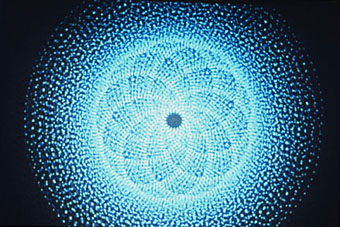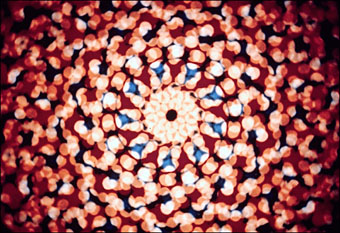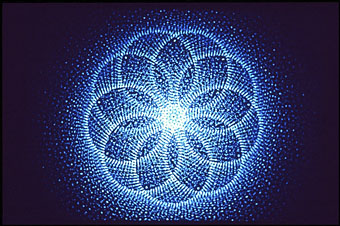
Lapis (1966).
Proof of the conservative nature of cinema as an artistic medium can be found in the way its abstract practitioners don’t merit anything like the attention received by Piet Mondrian or Jackson Pollock. In cinema narrative is all, and it’s ironic that when artists such as Julian Schnabel or Robert Longo turn to film they end up telling stories.

James Whitney’s Lapis (1966) is a classic work in this field, a 10-minute animation that took three years to create using primitive computer equipment:
In this piece smaller circles oscillate in and out in an array of colors resembling a kaleidoscope while being accompanied with Indian sitar music. The patterns become hypnotic and trance inducing. This work clearly correlates the auditory and the visual and is a wonderful example of the concept of synaesthesia.

James and his brother John were pioneers of the use of computers in animation. Looking around for stills from Lapis turned up this fascinating page of early computer graphics:
In the early 1960s digital computers became available to artists for the first time (although they cost from $100,000 to several millions, required air conditioning, and therefore located in separate computer rooms, uninhabitable ‘studios’; programs and data had to be prepared with the keypunch, punch cards then fed into the computer; systems were not interactive and could produce only still images). The output medium was usually a pen plotter, microfilm plotter (hybrid bwn vector CRT and a raster image device), line printer or an alphanumeric printout, which was then manually transferred into a visual medium.
It’s difficult to see these films outside a special screening at a gallery or arts cinema. The Keith Griffiths documentary Abstract Cinema is an excellent introduction, including both Lapis and James Whitney’s Yantra among many other short works. However, this isn’t available to buy so viewing it means scouring TV schedules or waiting for some of these neglected works to turn up on YouTube. Gene Youngblood’s 1970 book Expanded Cinema discusses abstraction and the Whitneys and is available as a free PDF download here.
Update: Lapis on YouTube again, in full this time!
Elsewhere on { feuilleton }
• The abstract cinema archive

Hello, I just wanted to tell you how great it was to find this page on Google. My grandmother’s cousin was James Whitney and I saw some of his works in the Visual Music exhibit at MOCA in LA in 2005. This however was before I really realized the importance of his work. Since then, I’ve garnered a deep interest in the arts and am studying the subject at Bucknell University in PA. Recently, some friends and I have been quite into computer graphics and code and it’s aesthetic uses (www.electricsheep.org or the Milkdrop Visualizer on the Winamp music player for PC). Our crazed interest only fueled my desire to go back and find works by my great-cousins(?) (his brother was an artist, too) so that I could then appreciate them in the way I was unable to when I saw their works at MOCA three years ago. This post has been informative for me and has shown me some good sites where I may research them but I’m curious if you have found anything else that you did not mention in the post. Could you let me know? I would be extremely grateful for your help.
Hi Sandy and thanks, that’s great to hear.
There is other stuff online but it’s not always that informative, mainly mentions of the films and so on. Best starting place is probably the Wikipedia entry which has links and a list of books or other publications discussing James Whitney:
James_Whitney_(filmmaker)
Some good pointers there to longer articles but this field remains sadly under-represented on the web. Best overall introduction is probably the Keith Griffiths documentary mentioned above, since that features extracts from many of the key works. But I’ve no idea how you’d get to see that unless it can be hired somewhere.
Nice article on Lapis. I have been doing a lot of research as of late on avant-garde cinema, and have been looking into the works of the Whitney’s. Lapis is such an interesting work, because of the concepts explored in visual music; it is also very telling of the times in which it was made. I believe Lapis was created using a series of perforated index cards and John Whitney’s “optical printer” to record the light shining through the holes. Creating this apparatus AND working with 16mm film on top of the hours of positioning each card correctly must have been painstaking! Kerry Brougher has a great article in the book “Visual Music: Synaesthesia In Art And Music Since 1900” if you are interested!
I saw Lapis at the Whitney Museum today and loved it. Does anyone know if it is available on DVD and where to get it?
Hi Neil,
I haven’t seen any mention of Lapis being available on DVD yet but a clip has turned up on YouTube:
http://youtube.com/watch?v=iVKNI_TxoH8
And there’s also one of John Whitney’s early computer works:
http://www.youtube.com/watch?v=w7h0ppnUQhE&NR=1
The translab page (“this fascinating page” link) on early computer art is very informative. Many of the works and related pieces were shown at the Scratch Code exhibit at Bitforms Gallery in 2004.
It seems that the clip of Lapis on YouTube has been removed.
A shame about the YouTube removal but I expect it’ll turn up elsewhere. Would be nice if that meant there was a DVD about the Whitneys’ work being planned.
We would like to purchase a copy of James Whitney’s “Lapis” and “Yantra” on dvd format (if available). Could you please tell me where we can obtain a copy of these two titles? These programs will be restricted to classroom instruction only. Any info will be greatly appreciated. Thank you…..Romea Montanaro
Hi Romea. I don’t think those films are on DVD yet but if anyone is going to do a Whitney DVD it’s these people:
http://www.centerforvisualmusic.org/
They already do great collections of work by Jordan Belson and Oskar Fischinger.